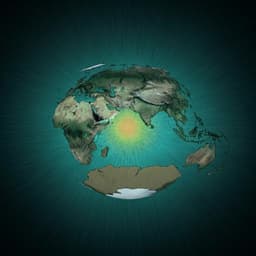
Earth Sciences
Skilful predictions of the Asian summer monsoon one year ahead
Y. Takaya, Y. Kosaka, et al.
Discover how a groundbreaking study by Yuhei Takaya, Yu Kosaka, Masahiro Watanabe, and Shuhei Maeda reveals the potential to predict the Asian summer monsoon and tropical cyclone activity over a year in advance, thanks to advanced climate modeling techniques and a large ensemble hindcast method!
~3 min • Beginner • English
Introduction
The Asian summer monsoon strongly influences precipitation, temperature, floods, droughts, and tropical cyclone activity across densely populated Asia, with major implications for water security, food production, and economies. Despite its importance, long-range prediction remains difficult due to complex atmosphere–land–ocean interactions, interbasin teleconnections, internal atmospheric variability, and limited predictability, especially over the tropical western North Pacific where rainfall is weakly linked to local SST. Recent advances in coupled models and initialization have extended useful seasonal predictions to roughly half a year, and emerging understanding of Indo–western North Pacific variability suggests potential for longer leads. This study investigates whether skilful predictions of the Indo–western North Pacific (Indo-WNP) summer monsoon are achievable more than one year in advance, and examines the mechanisms—particularly ENSO evolution and the delayed Indian Ocean influence (the Indo–western Pacific Ocean capacitor, IPOC)—that underpin such extended predictability.
Literature Review
Prior work has established the societal relevance and variability of Asian monsoons and the challenges in seasonal forecasting, including model biases and the spring predictability barrier for ENSO. Studies have highlighted weak local SST control over WNP summer rainfall, limiting direct local predictability. However, improvements in coupled models, initialization, and multi-model ensembles have enhanced seasonal forecast skill. Mechanistic studies identified the Indo–western Pacific Ocean capacitor (IPOC) mode, where post-ENSO Indian Ocean warming persists into boreal summer, forcing atmospheric responses over the WNP that modulate monsoon circulation, rainfall, and tropical cyclone activity. Predictability tied to the subtropical high and Indian Ocean SST has been proposed as a pathway for extended-lead monsoon and TC forecasts. This work builds upon these insights to test year-ahead skill and quantify the roles of ENSO and IPOC.
Methodology
Prediction experiment: A 16‑month ensemble prediction using the JMA/MRI-CPS2 coupled atmosphere–ocean–sea ice–land seasonal prediction system was conducted with 52 members for start dates every April (April 11, 16, 21, 26), spanning 1979–2016. The atmospheric model resolution is ~110 km in midlatitudes with 60 levels up to 0.01 hPa; ocean resolution is 0.5° × 1.0° with 0.3° near-equatorial refinement. Initial conditions: ocean from MOVE/MRI.COM-G2, atmosphere and land from JRA‑55 analyses. Ensemble spread is generated with slightly perturbed initial conditions and a stochastic physics scheme. Analyses focus on the second boreal summer (June–August; ~13‑month lead) against observations/reanalysis.
Observational data: JRA‑55 for winds, geopotential height, 2 m air temperature, and sea level pressure; COBE‑SST for SST; GPCP v2.3 for precipitation. Data are regridded to 2.5° for general analysis and 1.5° for TC analysis. RSMC Tokyo best track data are used for observed TC activity (tropical storms and stronger, max winds >17.2 m s−1).
Climate indices: NINO3.4 SST anomaly (5°N–5°S, 170°W–120°W) for ENSO; Indian Ocean Basin (IOB) SST anomaly (20°N–20°S, 40°E–100°E); WNP monsoon index defined as 850‑hPa zonal wind difference between 22.5°–32.5°N, 110°–140°E and 5°–15°N, 90°–130°E; WNP rainfall (10°–20°N, 115°–140°E); Ganges basin rainfall (22.5°–30°N, 75°–90°E); Indochina land surface 2 m air temperature (7.5°–20°N, 92.5°–110°E). Indices are standardized.
Skill evaluation: Pearson correlation between ensemble-mean predictions and observations, with p-values from Student’s t distribution. Detrended correlations are also reported where relevant.
Theoretical ensemble-size dependence: Expected ensemble-mean correlation CM as a function of ensemble size M estimated under a perfect-model assumption via CM = [1 + (M − 1) C1^2]^{1/2}, where C1 is expected single-member skill.
Tropical cyclone (TC) evaluation: Seasonal TC density for June–August computed from 6-hourly data. Model TCs are objectively detected/tracked at 1.5° × 1.5° using criteria on SLP minima, 850‑hPa vorticity thresholds, 200–500 hPa thickness anomaly, and upper–lower tropospheric wind relation, persisting ≥12 h. Post-genesis tracking applies relaxed thresholds. The monsoon trough (MT) index is area‑integrated 850‑hPa relative vorticity over 5°–20°N, 130°E–180°. Composite analyses of TC density use observed NINO3.4 and IOB thresholds, and a bivariate regression-based grouping for neutral–moderate ENSO years to isolate ENSO vs IOB effects.
Key Findings
- Year-ahead (second-summer) skill: The model skilfully predicts Indo–WNP monsoon circulation and associated hydroclimate at ~13‑month lead.
- WNP monsoon index: r = 0.50 (p < 0.005).
- NINO3.4 SST (second summer): r = 0.41 (p = 0.012); detrending improves NINO3.4 skill due to an overestimated warming trend.
- IOB SST: r = 0.70 (p < 0.001); detrended r_a = 0.52; skill remains high through the second summer.
- WNP rainfall index: r = 0.52 (p < 0.001).
- Ganges basin rainfall: r = 0.48 (p < 0.005).
- Indochina 2 m land temperature: r = 0.75 (p < 0.001).
- Spatial correlation maps show significant skill for 850‑hPa zonal winds, SST/LST, and precipitation consistent with Indo‑WNP monsoon variability and potential predictability.
- Mechanism: Skill arises from accurate simulation of ENSO evolution and the delayed Indian Ocean response (IPOC mode) that persists into the subsequent summer, forcing a WNP anticyclone, suppressed WNP convection, Maritime Continent rainfall enhancement, and Pacific–Japan teleconnection. Excluding summers following major El Niños degrades IOB and WNP monsoon skill, confirming the importance of preceding ENSO for second‑summer predictability.
- Ensemble size dependency: Second-summer skill is low with small ensembles (<10 members) but becomes statistically significant with larger ensembles (>20 members); skill growth matches theoretical expectations and has not fully saturated at 52 members, indicating room for further improvement.
- Tropical cyclone predictions:
- WNP TC density (JJA): first summer r = 0.67 (p < 0.001); second summer r = 0.39 (p = 0.017). For JAS in the second year: r = 0.35 (p = 0.035).
- Monsoon trough (MT) index: first summer r = 0.83 (p < 0.001); second summer r = 0.51 (p < 0.005).
- Composites and regressions show competing effects: warm IOB suppresses MT and TC activity (IPOC), while warm ENSO shifts MT southeastward increasing TC lifetimes; predictions capture these patterns, including suppressed activity in 1988 and 1998.
Discussion
The study demonstrates that extended-lead predictability of the Asian summer monsoon is achievable when models accurately simulate ENSO’s lifecycle and the subsequent Indian Ocean warming that sustains into the following summer (IPOC mode). This delayed Indian Ocean influence drives a coherent Indo–WNP atmospheric response—Kelvin-wave-induced WNP anticyclone, suppressed WNP convection, enhanced Maritime Continent rainfall, and a Pacific–Japan teleconnection—linking oceanic anomalies to continental hydroclimate and temperature, and underpinning skill for WNP rainfall, Indochina temperatures, and Ganges precipitation. Skill assessments indicate that preceding El Niño events contribute more to second-summer predictability than concurrent ENSO. For tropical cyclones, predictability derives from the monsoon trough modulation by IPOC and ENSO, with competing influences that the model captures. Achieving useful second-summer skill requires large ensembles to overcome low signal-to-noise; theoretical and empirical ensemble-size dependencies align. Some model biases, such as a weaker observed El Niño–La Niña transition, can limit WNP monsoon skill, but overall, the predicted patterns and teleconnections are consistent with observations and expected potential predictability.
Conclusion
Using a large-ensemble JMA/MRI-CPS2 hindcast, the study shows that meaningful predictions of the Indo–WNP monsoon circulation, associated rainfall and temperature over Asia, and WNP tropical cyclone activity are possible more than one year in advance. The primary source of year-ahead skill is the delayed ENSO influence mediated by persistent Indian Ocean anomalies (IPOC), combined with model fidelity in reproducing associated atmospheric teleconnections. Practical forecast skill depends strongly on ensemble size, with further gains expected from even larger ensembles. Future improvements should target enhanced ENSO prediction through the second summer, better representation of the IPOC processes and WNP air–sea coupling, and potentially larger ensemble sizes to increase signal-to-noise, thereby extending applications to water resource management and disaster risk reduction in Asia.
Limitations
- ENSO spring predictability barrier limits concurrent ENSO predictability; second-summer NINO3.4 skill is only moderate.
- Model overestimates the warming trend of NINO3.4 SST; detrending improves its skill.
- Tendency for a weaker transition from El Niño to La Niña than observed, which can limit WNP monsoon prediction skill.
- Second-summer skill is sensitive to ensemble size; small ensembles (<10) yield low, often insignificant correlations.
- Skill for second-year JAS TC activity (r ≈ 0.35) is lower than for JJA and declines with increasing lead time as delayed ENSO influence dissipates.
- Predictive skill is higher in years following strong El Niños; years without such precursors may see reduced skill.
- Actual skills remain below estimated potential predictability, indicating remaining model and initialization limitations despite no apparent signal-to-noise paradox.
Related Publications
Explore these studies to deepen your understanding of the subject.







